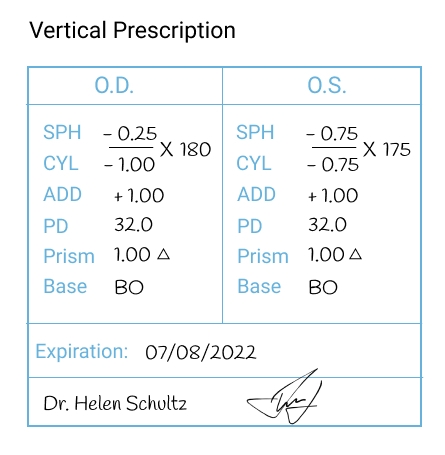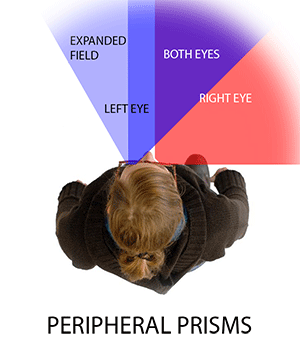In optics, a prism is a transparent optical element with flat, polished surfaces that refract light. At least two of the flat surfaces must have an angle between them. The exact angles between the surfaces depend on the application. The traditional geometrical shape is that of a triangular prism with a triangular base and rectangular sides, and in colloquial use "prism" usually refers to this type. Some types of optical prism are not in fact in the shape of geometric prisms. Prisms can be made from any material that is transparent to the wavelengths for which they are designed. Typical materials include glass, plastic and fluorite.[1]
The simple definition of a prism is a solid object that has the same cross-section along the entire length of its shape. When you cut straight across an object, the cut portion is called a cross-section. Draw any shape using straight lines. Now use your imagination to see it extend upward and that is a prism. eResearch by Navid Ajamin -- spring 2016

Some people require prismatic power to better align the image to their eyes.
Prism helps with both vertical and horizontal eye alignment problems. This problem is relatively uncommon, but if you require prism you’ll see both the magnitude and the orientation specified on your glasses prescription. The value is reported in 0.25 Diopter increments. The orientation could be in one of four directions: base up (BU), base down (BD), base out (BO) or base in (BI).
In the science dedicated to the study and treatment of eye diseases, ophthalmologists have used prisms since the 19th century to diagnose and treat many diseases of the eye, including esotropia, exotropia, nystagmus and amblyopia.
When diagnosing eye diseases or deficiencies, ophthalmologists employ prism-refracted light to exam different parts of the eye for problems. Prisms used to treat disease help redirect light entering the eye to enhance the vision of the patient.
Prisms also figure in the construction of corrective vision lenses for individuals suffering from certain diseases of the eye or specific types of vision deficiencies.[4]

In eyeglasses, prisms are used primarily for double vision, positional correction, or convergence correction.
Double vision (diplopia) is when a viewer sees two individual images using both eyes, instead of the one most people see, merged together by the brain. Some people with diplopia see only a single image, but it is blurred. Others, when using only one eye, do not see in 3-D, but a single, flat image.

This is the result of one eye needing positional correction. If both eyes are affected (not working in unison), a misconvergence occurs, meaning the image seen by each eye needs to be repositioned individually in order to become a single one. Sometimes, diplopia is even caused by wearing eyeglasses, and adding prisms can correct this.
Eye care professionals use prism correction as a component of some eyeglass prescriptions. A lens which includes some amount of prism correction will displace the viewed image horizontally, vertically, or a combination of both directions. The most common application for this is the treatment of strabismus. By moving the image in front of the deviated eye, double vision can be avoided and comfortable binocular vision can be achieved. Other applications include yoked prism where the image is shifted an equal amount in each eye. This is useful when someone has a visual field defect on the same side of each eye.
 Prism lenses (here unusually thick) are used for pre-operative prism adaptation.
Prism lenses (here unusually thick) are used for pre-operative prism adaptation.
Individuals with nystagmus, Duane's retraction syndrome, 4th Nerve Palsy, and other eye movement disorders experience an improvement in their symptoms when they turn or tilt their head. Yoked prism can move the image away from primary gaze without the need for a constant head tilt or turn.[9]

Prism correction is measured in prism dioptres. A prescription that specifies prism correction will also specify the "base". The base is the thickest part of the lens and is opposite from the apex. Light will be bent towards the base and the image will be shifted towards the apex. In an eyeglass prescription, the base is typically specified as up, down, in, or out, but left and right are also used sometimes. Whether a patient needs this type of correction can be determined by a variety of methods.
Prism eyeglasses are enough to correct these abnormalities if the person has nearly normal vision in their level of nearsightedness or farsightedness. However, if one of the eyes has greatly reduced vision or blindness, there could be physical or neurological issues causing the diplopia. This would then require surgery to repair the eye muscles in addition to the use of the corrective prism lenses.
Standard eyeglasses usually correct two types of eyesight errors, or a combination of both: focal distance (near or farsightedness), or unusual curving of the cornea (astigmatism and cylinder).
Like normal eyeglasses, a prism is measured and prescribed with a unit of measurement called prism diopters (from 0.5PD, 1.0PD, 1.5PD, and so on). Depending on your double vision, the prism is placed vertically, horizontally or diagonally in one or both lenses of your eyeglasses.

People’s brains can normally transform the images seen by each eye into one, singular image when the eyes are aligned. This is known as Binocular Vision. When patients have BVD, it means they have a slight misalignment between their eyes, and their brains struggle to process these two misaligned images into one singular image. The struggling results in headaches, dizziness, and double vision, among other symptoms. Prism glasses contain specialized lenses that correct the misalignment, which eliminates the struggling and significantly reduces or eliminates the occurrence of symptoms.[13]
Prism. This is the amount of prismatic power, measured in prism diopters ("p.d." or a superscript triangle when written freehand), prescribed to compensate for eye alignment problems. Only a small percentage of eyeglass prescriptions include prism.
When present, the amount of prism is indicated in either metric or fractional English units (0.5 or ½, for example), and the direction of the prism is indicated by noting the relative position of its "base" or thickest edge. Four abbreviations are used for prism direction: BU = base up; BD = base down; BI = base in (toward the wearer's nose); BO = base out (toward the wearer's ear).
Sphere power, cylinder power and add power always appear in diopters. They are in decimal form and generally are written in quarter-diopter (0.25 D) increments. Axis values are whole numbers from 1 to 180 and signify only a meridional location, not a power. When prism diopters are indicated in decimal form, typically only one digit appears after the period (e.g., 0.5).[3]
Prism lenses are necessary to aid in getting the eyes to work together. One or both eyes tend to pull up, down, to the left, or to the right. The use of prism in the lenses tricks the brain into thinking the eyes are working together by shifting the image only slightly up, down, left, or right.

Recently, prisms have been helping people with hemianopia. This condition causes blindness in half of the visual field in both eyes—either the left or the right field. It is most common to brain injury and stroke victims, and sometimes each eye is defective in exactly the same way. Other times, each eye is affected differently. Less common is the lack of sight in the upper or lower fields of vision.
A fresnel prism is a thin, transparent plastic sheet which induces a prismatic effect (it alters the direction of the image entering the eye). One side consists of a series of angular grooves (prisms) and the other smooth side attaches to the lens of your glasses.[5]
Fresnel prisms are made up of tiny prisms lined up base to apex on a thin platform of plastic. Fresnel prisms are thinner and lighter than conventional prisms and bend light in the same manner. Their optical quality is not quite as good as conventional prisms.[6]
Quadrantanopia is the same condition, but one quarter of the eye is blind. The particular field affected can be left, right, upper, or lower, and can also be the same or different in each eye.
 Bed Prism Glasses / Lazy Glasses
Bed Prism Glasses / Lazy Glasses
When a ray of light enters the glass prism it gets deviated two times. First when it enters the glass prism and second when it comes out of the prism. This is because the refracting surfaces of the prism are not parallel to each other. Also, when the ray of light passes through the prism it bends towards its base.

In 1665, Isaac Newton discovered that white light consists of seven colours. He found that if a beam of white light is passed through glass prism then it will split in to seven colours. These colours are red, orange, yellow, green, blue, indigo and violet (VIBGYOR).
Spectrum of white light: The band of seven colours formed when a beam of white light is passes through a glass prism is called spectrum of white light.
Dispersion of light: The splitting of white light into seven colours on passing through a transparent medium is called dispersion of light.[7]
.jpg)
Since peripheral vision is most often affected, prisms are ground into the lenses to show an image outside the range of sight, simply by placing the prisms within the viewer’s sighted area. This alerts them to something which would normally not be seen and they can then turn to observe it more closely, thereby avoiding running into people or objects simply from lack of seeing them.[2]
There are various applications for prisms. They are made in many different forms and shapes to suit specific applications. Prisms are heavily used in optical applications such as microscopes, lenses, telescopes and laser diodes.
Who might benefit from prism correction?
A prism can be used for double vision from eye misalignment when caused by:
- Eye muscle problems, such as myasthenia gravis, Graves’ disease, or strabismus (crossed eyes or wall eyes)
- Neurological (brain-related) issues, such as head injuries, stroke, migraine, or tumor.
- Nerve-related problems, like multiple sclerosis or diabetes mellitus
Double vision has many causes, and a prism isn't helpful for all types of double vision. Because it can be a sign of a serious health condition, it's important to find out what's causing double vision.
See a doctor immediately if your double vision:
- is new,
- is caused by eye misalignment,
- or happens for unknown reasons.
How is a prism prescribed?
You may need to do one or more of these tests to get a prism for your glasses:
Hirschberg test. This basic test helps check for strabismus. A pen light is aimed at the eyes. When the patient looks at the light, the corneal reflection should appear in the center of the pupil in each eye. If the reflection is off-center in either or both eyes, there may be strabismus.
Child being tested for strabismus with corneal light reflex. Asymmetrical reflections of light in eyes show child may have strabismus.
Off-center corneal reflection of light in left eye, showing possible strabismus
Krimsky test. This test helps measure the degree of misalignment. This is like the Hirschberg test, but with a prism. While looking at the pen light, prisms of different strengths are placed in front of the eye. When a prism brings the reflection in each eye to the center, the correct prism measurement has been found.
Cover tests. There are three types of cover tests. With the cover/uncover test, one eye is covered and one is left uncovered. The doctor looks for any movement in the eye that is uncovered. The prism and alternate cover test alternates the cover over both eyes while a prism is placed in front of one eye. This helps measure the offset (difference) between the two eyes and determine what prism is needed to fix your double vision. With the Maddox test, each eye sees a vertical or horizontal line. The offset of these images allows the doctor to determine what type of double vision you have. Prisms are also used to measure distance between the two images.
Sometimes, a temporary Fresnel prism (a thin press-on vinyl sticker) is fitted over the front of your eyeglasses. With a Fresnel prism lens, the prism is slightly visible. This isn't ideal for long-term use, but it does allow you to test drive a prism and see how it works. Fresnel prisms are also used when the prism prescription isn't stable and may change soon.
If prism correction is needed for a longer period, it can be ground into (made part of) the lens of your eyeglasses. Eyeglasses with a prism look like any other glasses without a prism, although the lens on one side may be thicker and more noticeable.[10]

Reference:
- en.wikipedia.org/wiki/Prism
- glassescrafter.com
- allaboutvision.com/eyeglasses
- sciencing.com/uses-prisms-
- hemianopia.org/index_files/Howprismswork.htm
- ekhuft.nhs.uk/EasySiteWeb/GatewayLink.aspx?alId=77684
- jagranjosh.com/general-knowledge/refraction-of-light-through-a-glass-prism
- azooptics.com/Article.aspx?ArticleID=723
- en.wikipedia.org/wiki/Prism_correction
- aao.org/eye-health/glasses-contacts/what-is-prism-correction-in-eyeglasses
- overnightglasses.com
- chadwickoptical.com
- vsofm.com/prism-glasses
See also:
- Ophthalmic prisms slideshare.net
 وبلاگ تخصصی عینک شامل مجموعه مطالب پزشکی است که اطلاعات مفیدی در رابطه با عینک , چشم، لنز، سلامتی چشم و راه های پیشگیری از بیماریهای چشمی، کنترل و درمان آن را در اختیار شما کاربر محترم می گزارد.
وبلاگ تخصصی عینک شامل مجموعه مطالب پزشکی است که اطلاعات مفیدی در رابطه با عینک , چشم، لنز، سلامتی چشم و راه های پیشگیری از بیماریهای چشمی، کنترل و درمان آن را در اختیار شما کاربر محترم می گزارد.